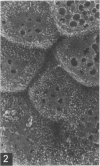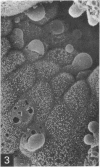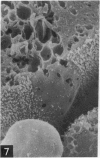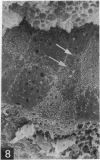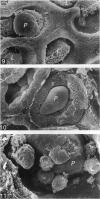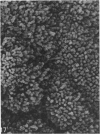Abstract
Scanning electron microscopy of the epithelial cells of the female hamster harderian gland reveals a range of surface features. Some cells exhibit a uniform covering of microvilli while others, often with swollen apices, are relatively devoid of microvilli. Surface pitting is frequent for all cells; pits represent regions of exocytotic lipid vacuole release. A similar range of surface appearances occurs in the male gland but here cells with uniform microvilli represent type I cells (characterised by small lipid vacuoles) while swollen cells with sparse microvilli are type II cells (characterised by large lipid vacuoles). It is suggested that different cell forms represent a single cell type in varying activity states. Luminal debris is often marked, consisting chiefly of lipids. Solid porphyrin accretions, sometimes surrounded by neutrophils, are numerous in female (but not male) glands. Interstitial mast cells are also numerous in the female gland. The gland contains fenestrated capillaries and extensive lymphatics. The duct of the gland, which has received little attention, possesses ciliated cells, nonciliated cells and basal cells. Ciliated cells possess kinocilia and relatively tall thin microvilli, as well as some lipid vacuoles. Nonciliated cells bear shorter microvilli, apically located mucoid granules, and lamellar formations of smooth endoplasmic reticulum. The basal cells are squat and pyramidal; their lateral walls, which interdigitate with the main duct cell types, show pronounced folding.
Full text
PDF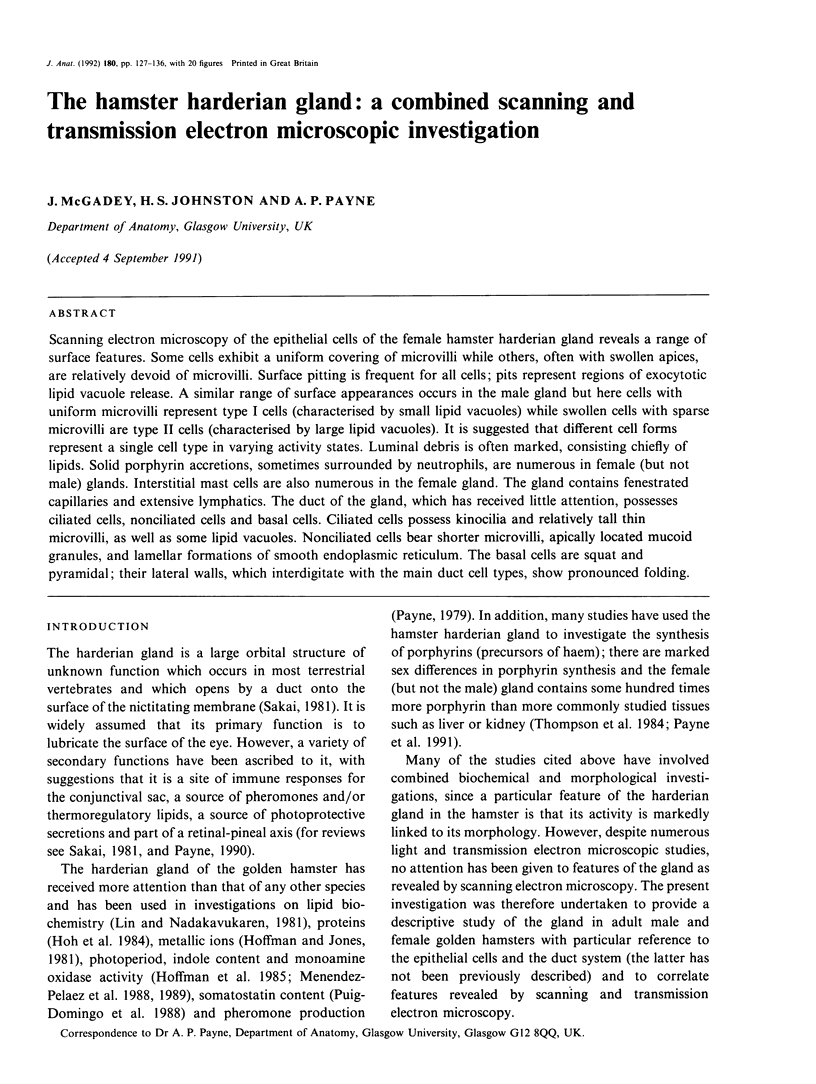

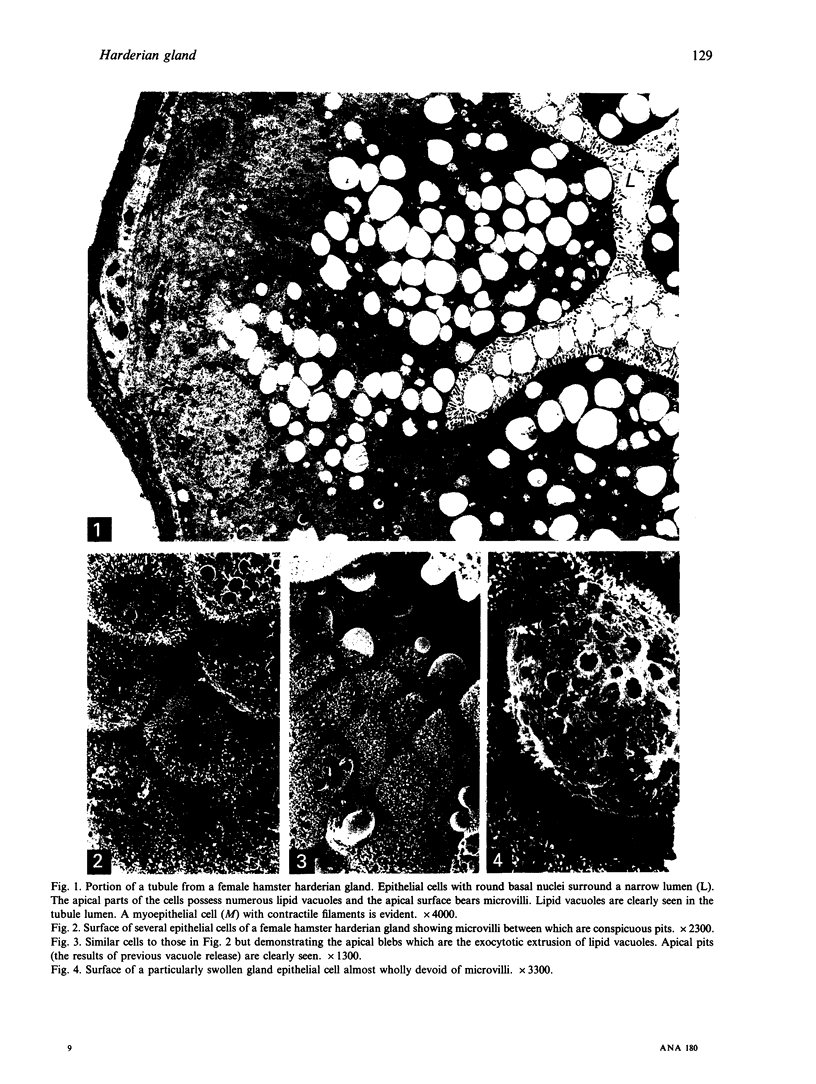
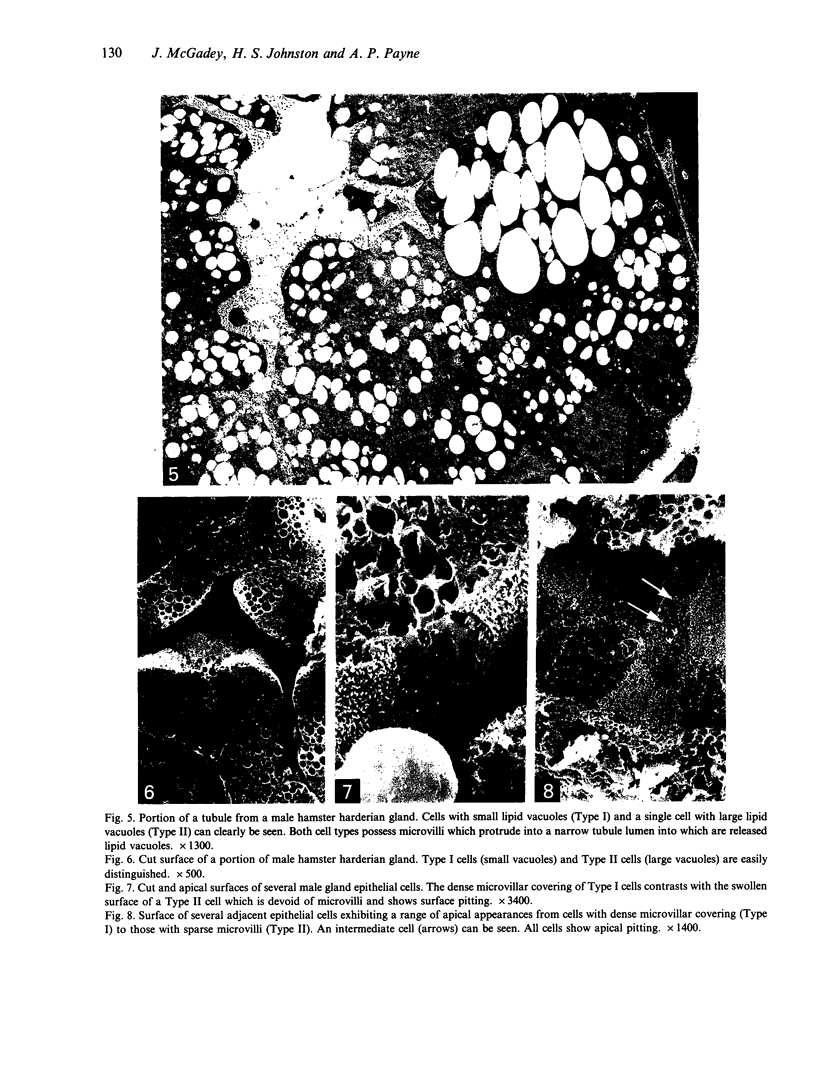



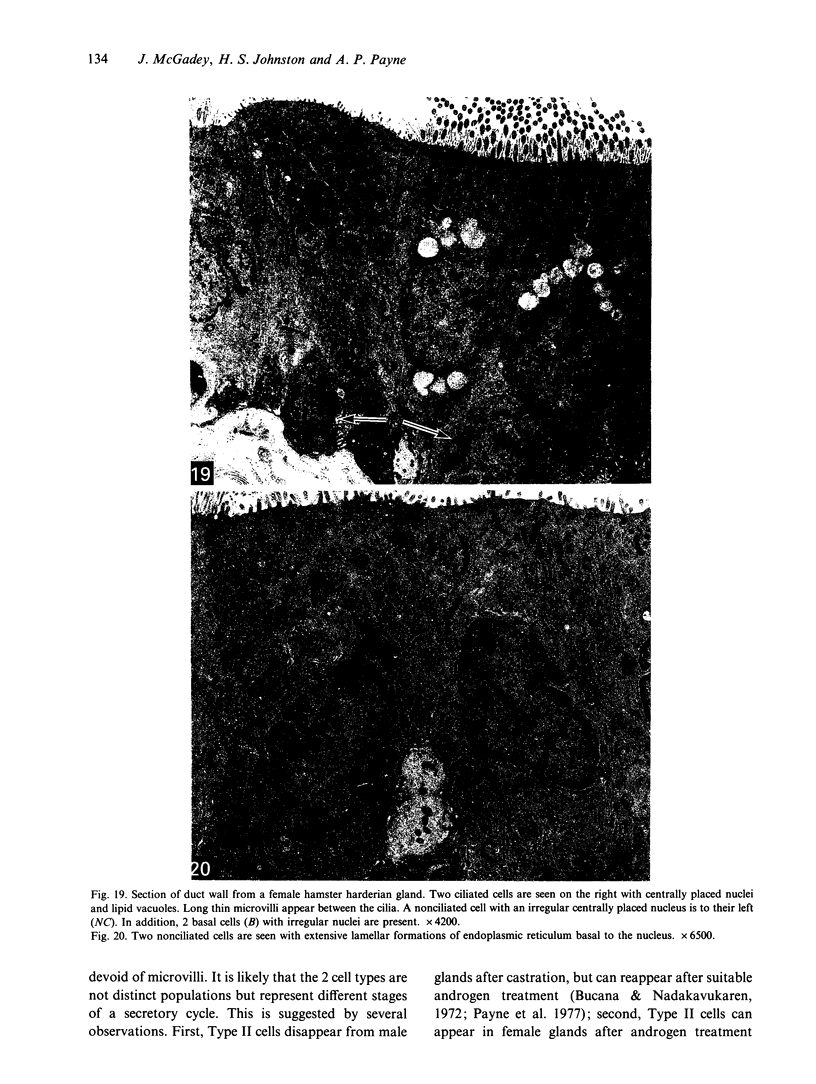
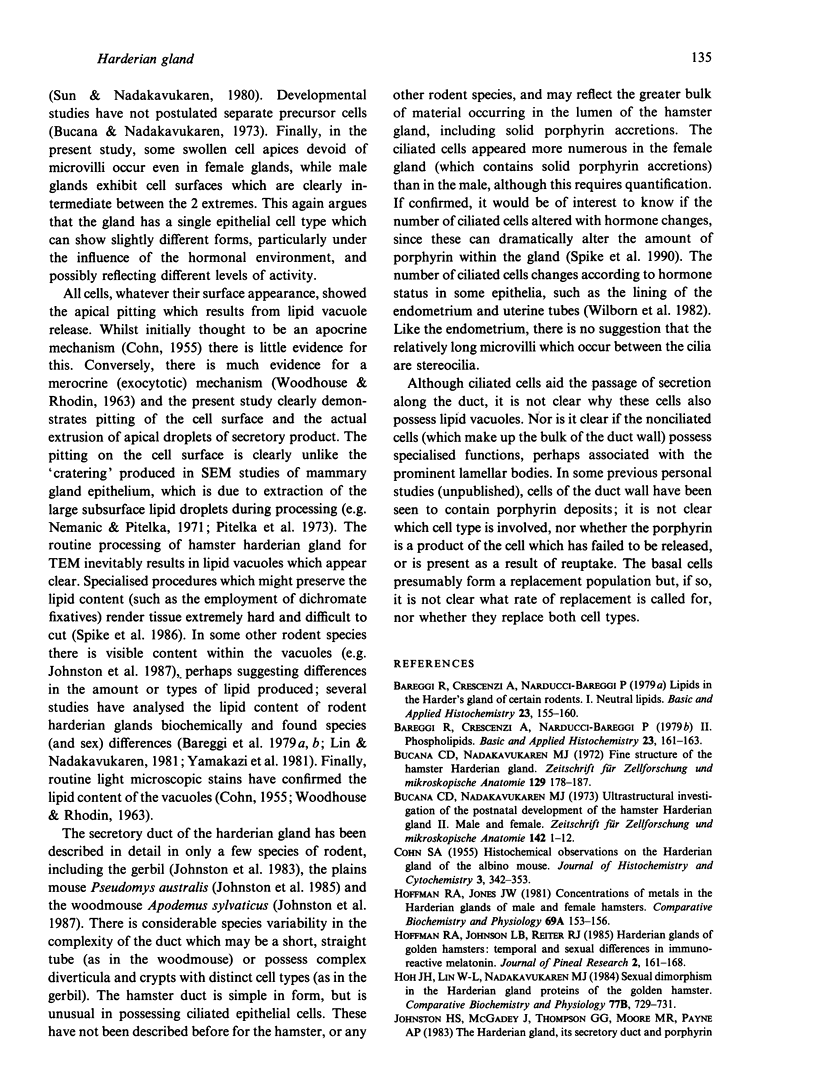
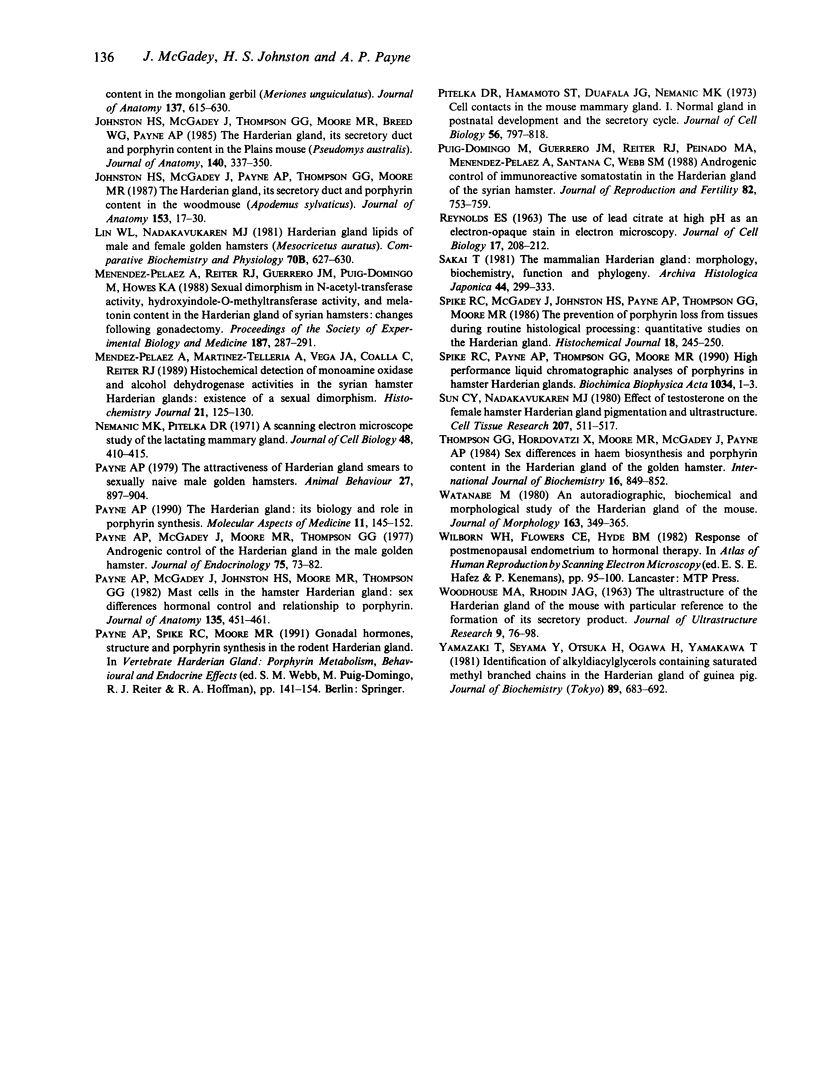
Images in this article
Selected References
These references are in PubMed. This may not be the complete list of references from this article.
- Bareggi R., Crescenzi A., Narducci-Bareggi P. Lipids in the Harder's gland of certain rodents. I: Neutral lipids. Basic Appl Histochem. 1979;23(2):155–160. [PubMed] [Google Scholar]
- Bareggi R., Crescenzi A., Narducci-Bareggi P. Lipids in the Harder's gland of certain rodents. II: Phospholipids. Basic Appl Histochem. 1979;23(2):161–163. [PubMed] [Google Scholar]
- Bucana C. D., Nadakavukaren M. J. Fine structure of the hamster Harderian gland. Z Zellforsch Mikrosk Anat. 1972;129(2):178–187. doi: 10.1007/BF00306934. [DOI] [PubMed] [Google Scholar]
- Bucana C. D., Nadakavukaren M. J. Ultrastructural investigation of the postnatal development of the hamster Harderian gland. II. Male and female. Z Zellforsch Mikrosk Anat. 1973 Aug 27;142(1):1–12. doi: 10.1007/BF00306700. [DOI] [PubMed] [Google Scholar]
- COHN S. A. Histochemical observations on the Harderian gland of the albino mouse. J Histochem Cytochem. 1955 Sep;3(5):342–353. doi: 10.1177/3.5.342. [DOI] [PubMed] [Google Scholar]
- Hoffman R. A., Johnson L. B., Reiter R. J. Harderian glands of golden hamsters: temporal and sexual differences in immunoreactive melatonin. J Pineal Res. 1985;2(2):161–168. doi: 10.1111/j.1600-079x.1985.tb00636.x. [DOI] [PubMed] [Google Scholar]
- Hoh J. H., Lin W. L., Nadakavukaren M. J. Sexual dimorphism in the Harderian gland proteins of the golden hamster. Comp Biochem Physiol B. 1984;77(4):729–731. doi: 10.1016/0305-0491(84)90304-3. [DOI] [PubMed] [Google Scholar]
- Johnston H. S., McGadey J., Payne A. P., Thompson G. G., Moore M. R. The Harderian gland, its secretory duct and porphyrin content in the woodmouse (Apodemus sylvaticus). J Anat. 1987 Aug;153:17–30. [PMC free article] [PubMed] [Google Scholar]
- Johnston H. S., McGadey J., Thompson G. G., Moore M. R., Breed W. G., Payne A. P. The Harderian gland, its secretory duct and porphyrin content in the Plains mouse (Pseudomys australis). J Anat. 1985 Mar;140(Pt 2):337–350. [PMC free article] [PubMed] [Google Scholar]
- Johnston H. S., McGadey J., Thompson G. G., Moore M. R., Payne A. P. The Harderian gland, its secretory duct and porphyrin content in the mongolian gerbil (Meriones unguiculatus). J Anat. 1983 Oct;137(Pt 3):615–630. [PMC free article] [PubMed] [Google Scholar]
- Menendez-Pelaez A., Martinez-Telleria A., Vega J. A., Coalla C., Reiter R. J. Histochemical detection of monoamine oxidase and alcohol dehydrogenase activities in the Syrian hamster Harderian glands: existence of a sexual dimorphism. Histochem J. 1989 Mar;21(3):125–130. doi: 10.1007/BF01007486. [DOI] [PubMed] [Google Scholar]
- Menendez-Pelaez A., Reiter R. J., Guerrero J. M., Puig-Domingo M., Howes K. A. Sexual dimorphism in N-acetyltransferase activity, hydroxyindole-O-methyltransferase activity, and melatonin content in the Harderian gland of Syrian hamsters: changes following gonadectomy. Proc Soc Exp Biol Med. 1988 Mar;187(3):287–291. doi: 10.3181/00379727-187-42666. [DOI] [PubMed] [Google Scholar]
- Nemanic M. K., Pitelka D. R. A scanning electron microscope study of the lactating mammary gland. J Cell Biol. 1971 Feb;48(2):410–415. doi: 10.1083/jcb.48.2.410. [DOI] [PMC free article] [PubMed] [Google Scholar]
- Payne A. P., McGadey J., Johnston H. S., Moore M. R., Thompson G. G. Mast cells in the hamster Harderian gland: sex differences, hormonal control and relationship to porphyrin. J Anat. 1982 Oct;135(Pt 3):451–461. [PMC free article] [PubMed] [Google Scholar]
- Payne A. P., McGadey J., Moore M. R., Thompson G. Androgenic control of the harderian gland in the male golden hamster. J Endocrinol. 1977 Oct;75(1):73–82. doi: 10.1677/joe.0.0750073. [DOI] [PubMed] [Google Scholar]
- Payne A. P. The attractiveness of Harderian gland smears to sexually naive and experienced male golden hamsters. Anim Behav. 1979 Aug;27(Pt 3):897–904. doi: 10.1016/0003-3472(79)90027-7. [DOI] [PubMed] [Google Scholar]
- Pitelka D. R., Hamamoto S. T., Duafala J. G., Nemanic M. K. Cell contacts in the mouse mammary gland. I. Normal gland in postnatal development and the secretory cycle. J Cell Biol. 1973 Mar;56(3):797–818. doi: 10.1083/jcb.56.3.797. [DOI] [PMC free article] [PubMed] [Google Scholar]
- Puig-Domingo M., Guerrero J. M., Reiter R. J., Peinado M. A., Menendez-Pelaez A., Santana C., Webb S. M. Androgenic control of immunoreactive somatostatin in the Harderian gland of the Syrian hamster. J Reprod Fertil. 1988 Mar;82(2):753–759. doi: 10.1530/jrf.0.0820753. [DOI] [PubMed] [Google Scholar]
- REYNOLDS E. S. The use of lead citrate at high pH as an electron-opaque stain in electron microscopy. J Cell Biol. 1963 Apr;17:208–212. doi: 10.1083/jcb.17.1.208. [DOI] [PMC free article] [PubMed] [Google Scholar]
- Sakai T. The mammalian Harderian gland: morphology, biochemistry, function and phylogeny. Arch Histol Jpn. 1981 Sep;44(4):299–333. doi: 10.1679/aohc1950.44.299. [DOI] [PubMed] [Google Scholar]
- Spike R. C., McGadey J., Johnston H. S., Payne A. P., Thompson G. G., Moore M. R. The prevention of porphyrin loss from tissues during routine histological processing: quantitative studies on the Harderian gland. Histochem J. 1986 May;18(5):245–250. doi: 10.1007/BF01676234. [DOI] [PubMed] [Google Scholar]
- Spike R. C., Payne A. P., Thompson G. G., Moore M. R. High-performance liquid chromatographic analyses of porphyrins in hamster Harderian glands. Biochim Biophys Acta. 1990 Apr 23;1034(1):1–3. doi: 10.1016/0304-4165(90)90144-l. [DOI] [PubMed] [Google Scholar]
- Sun C. Y., Nadakavukaren M. J. Effect of testosterone on the female hamster Harderian gland pigmentation and ultrastructure. Cell Tissue Res. 1980;207(3):511–517. doi: 10.1007/BF00224624. [DOI] [PubMed] [Google Scholar]
- Thompson G. G., Hordovatzi X., Moore M. R., McGadey J., Payne A. P. Sex differences in haem biosynthesis and porphyrin content in the Harderian gland of the golden hamster. Int J Biochem. 1984;16(7):849–852. doi: 10.1016/0020-711x(84)90201-5. [DOI] [PubMed] [Google Scholar]
- WOODHOUSE M. A., RHODIN J. A. THE ULTRASTRUCTURE OF THE HARDERIAN GLAND OF THE MOUSE WITH PARTICULAR REFERENCE TO THE FORMATION OF ITS SECRETORY PRODUCT. J Ultrastruct Res. 1963 Aug;49:76–98. doi: 10.1016/s0022-5320(63)80037-4. [DOI] [PubMed] [Google Scholar]
- Watanabe M. An autoradiographic, biochemical, and morphological study of the harderian gland of the mouse. J Morphol. 1980 Mar;163(3):349–365. doi: 10.1002/jmor.1051630308. [DOI] [PubMed] [Google Scholar]
- Yamazaki T., Seyama Y., Otsuka H., Ogawa H., Yamakawa T. Identification of alkyldiacylglycerols containing saturated methyl branched chains in the Harderian gland of guinea pig. J Biochem. 1981 Feb;89(2):683–691. doi: 10.1093/oxfordjournals.jbchem.a133246. [DOI] [PubMed] [Google Scholar]




